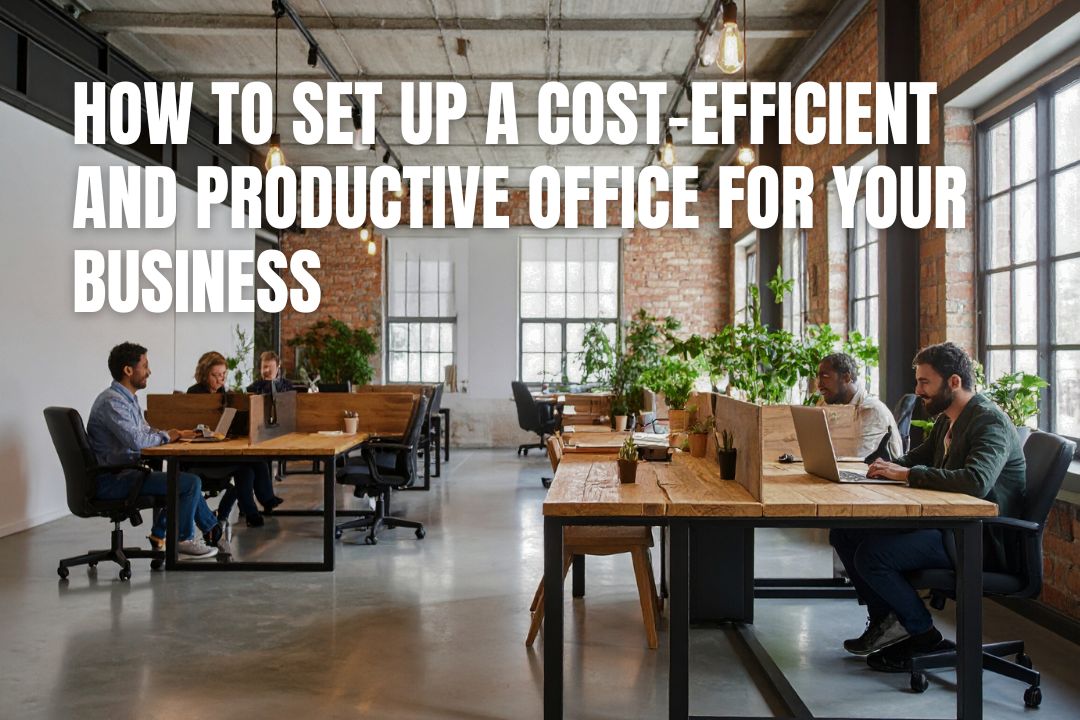How to Set Up a Cost-Efficient and Productive Office for Your Business
September 30, 2025

Whether you are just starting your business or you have decided that a business office is the next step in your existing business, you need to know how to set up an office space in the best and most cost-efficient way. An office space should boost morale and drive productivity. This can be achieved with a variety of different components within your office space, from the internet speed and hardware to the design, layout, and colours on the walls.
To help you set up the most cost-efficient and productive office for your business, here are some important top tips to help you get started.
Key Takeaways on Setting Up a Business Office
- Find a Suitable Location: Your office's location is paramount. Prioritise accessibility for employees and clients, ensuring good transport links, sufficient parking, and reliable internet connectivity.
- Be Compliant: Before signing any agreements, make sure you meet all legal obligations. This includes checking planning permissions and having a lawyer review your lease to avoid future complications.
- Check Health and Safety: You are responsible for your team's safety. Conduct a thorough assessment to confirm proper ventilation, lighting, fire safety measures, and clear exit routes are in place.
- Design An Efficient Layout: A well-planned layout directly impacts productivity. Create distinct zones for different tasks and use smart storage solutions to maintain a clutter-free environment that encourages focus and collaboration.
- Connect Your Business: Equip your office with high-speed internet that covers every workspace. Also, install essential phone lines, computers, and security systems to keep your operations running smoothly.
- Equip Your Office with Supplies: Stock up on all necessary items from the start. This includes everything from hardware and software to branded stationery, basic office supplies, and secure cloud storage.
Register Your LLC
Company Registration
START NOW
#1 - Find a Suitable Location
The location of your office is going to be the most important. You need to ensure that it is in a place that is accessible for your employees and clients if they will be attending your office. This means having sufficient parking and being located close to main roads and public transport. Check crime rates in the area, essential services, and things like internet connectivity and speed.
#2 - Be Compliant
In the process of your business office, you want to make sure that you tick all the right legal boxes before signing any contracts, so you don’t find yourself stuck. Check if any planning permission is required, get a lawyer to check over the lease agreements, and ensure you are able to meet any legal requirements, such as light, space, and facilities. Research any laws you need to follow.
#3 - Check Health and Safety
Health and safety is one of the most important parts of the office space, as you are going to be responsible. Ensure there is ventilation, lighting, fire escapes and protocols, exit routes, and accessibility. Conduct an assessment to ensure there are no hazards around the building that could cause injury.
#4 - Design An Efficient Layout
The layout and design of the office space are going to have a huge impact on communication, collaboration, productivity, morale, standards of work, and output. Dedicate different zones for different needs, such as meeting rooms, multi-functional spaces, a quiet area, and a breakout space. You want to find a balance with storing what you need in the office but creating a clutter-free and distraction-free place. Many businesses will build storage units to house day-to-day items, and hire secure site storage containers for large, important items that are not typically used but need to be kept. Choose mood boosting and productive colours to paint on the walls, leverage natural light sources and add some nature into the space.
#5 - Connect Your Business
Install high-speed internet in your office and ensure it reaches all workspaces in the building. Install phone lines, computers, security systems, and anything else you need in your office.
#6 - Equip Your Office with Supplies
Make sure your office is fully equipped. This may include:
- Hardware and software
- Branded stationery, including business cards, invoices, and letterheads
- Paper, pencils, pens, staplers, and other office supplies
- Cloud storage and security software
Running a business is difficult, and when you decide to bring an office into the mix, there are new challenges that you are going to face. Use these top tips to help you build a strategy for a successful office space for you, your employees, and your clients.
FAQs for How to Set Up a Cost-Efficient and Productive Office for Your Business
What is the most important factor when choosing an office location?
Accessibility should be your top priority. Choose a location that is easy for both your employees and clients to get to, with adequate parking and access to public transport. Don't forget to check for essential services like high-speed internet.
How can office design impact my team's productivity?
The layout and design of your office have a huge effect on morale and output. An efficient layout with dedicated zones for meetings, quiet work, and breaks can boost collaboration and focus. Using mood-boosting colours, natural light, and keeping the space clutter-free also helps.
What legal steps should I take before signing an office lease?
It's vital to ensure you are fully compliant with local regulations. You should check if any planning permission is needed, have a legal professional review the lease agreement, and confirm the space meets all legal requirements for light, space, and facilities.
What are the basic health and safety requirements for an office?
You must provide a safe environment. This includes ensuring there is adequate ventilation and lighting, clear fire escape routes and protocols, and general accessibility. A full hazard assessment is a good first step to identify and mitigate any potential risks.
How can I keep my office organised without it feeling cluttered?
A great strategy is to balance day-to-day storage with long-term solutions. Use on-site storage for frequently used items and consider secure off-site options for larger equipment or archives that you don't need daily. This helps maintain a productive, distraction-free workspace.

